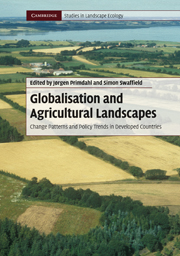Book contents
- Frontmatter
- Contents
- List of Contributors
- Preface
- 1 Globalisation and the sustainability of agricultural landscapes
- 2 Agricultural liberalisation, multifunctionality and the WTO: competing agendas for the future of farmed landscapes
- 3 Globalisation of agricultural landscapes: a land systems approach
- 4 Agricultural landscape changes through globalisation and biodiversity effects
- 5 Swiss agricultural policy reform: landscape changes in consequence of national agricultural policy and international competition pressure
- 6 Local landscape consequences of macro-scale policy reform: the New Zealand experiment
- 7 Rural landscape differentiation in the face of changing demands and policies: a typology of rural areas in Portugal
- 8 Globalisation and the local agricultural landscape: current change patterns and public policy interventions
- 9 From totalitarian to democratic landscapes: the transition in Estonia
- 10 Rural landscape change as a product of US federal policy
- 11 New approaches for urban–rural areas in Dutch spatial planning
- 12 Restoring agricultural landscapes in shrinking cities: re-inventing traditional concepts in Japanese planning
- 13 Globalisation and local agricultural landscapes: patterns of change, policy dilemmas and research questions
- Index
- References
7 - Rural landscape differentiation in the face of changing demands and policies: a typology of rural areas in Portugal
Published online by Cambridge University Press: 05 June 2012
- Frontmatter
- Contents
- List of Contributors
- Preface
- 1 Globalisation and the sustainability of agricultural landscapes
- 2 Agricultural liberalisation, multifunctionality and the WTO: competing agendas for the future of farmed landscapes
- 3 Globalisation of agricultural landscapes: a land systems approach
- 4 Agricultural landscape changes through globalisation and biodiversity effects
- 5 Swiss agricultural policy reform: landscape changes in consequence of national agricultural policy and international competition pressure
- 6 Local landscape consequences of macro-scale policy reform: the New Zealand experiment
- 7 Rural landscape differentiation in the face of changing demands and policies: a typology of rural areas in Portugal
- 8 Globalisation and the local agricultural landscape: current change patterns and public policy interventions
- 9 From totalitarian to democratic landscapes: the transition in Estonia
- 10 Rural landscape change as a product of US federal policy
- 11 New approaches for urban–rural areas in Dutch spatial planning
- 12 Restoring agricultural landscapes in shrinking cities: re-inventing traditional concepts in Japanese planning
- 13 Globalisation and local agricultural landscapes: patterns of change, policy dilemmas and research questions
- Index
- References
Summary
Introduction
The current Portuguese rural landscape and the changes through which it is being transformed are a compelling example of how diversified is the situation of European landscapes today. There are landscapes in Portugal that are dominated by farm production activities which are specialised and competitive in a global context – like the wine production regions – and in which other rural sectors are also dynamic. But most of the territory is occupied by less competitive land uses, under transition processes due to their low competitiveness. Nonetheless, in many areas such uses result in land-cover distributions that support many other landscape functions, such as the small-scale mosaic of mountain regions in the north, or the silvo-pastoral landscape dominant in all southern Portugal, with scattered oak trees in different densities over patches of grassland and shrub. These landscapes have a clear identity at a European scale, are environmentally balanced, and are rich in biodiversity and aesthetic values. In these areas, tourism as well as settlement of incomers (mainly urban people) is slowly developing.
However, the agriculture structure and practices which have produced and maintained these highly valuable landscapes are in an unstable condition. Some land-use systems are maintained due to the support payments that still exist, and through the attachment of people to the land, but the required innovation for their survival in the future is not taking place.
- Type
- Chapter
- Information
- Globalisation and Agricultural LandscapesChange Patterns and Policy trends in Developed Countries, pp. 127 - 148Publisher: Cambridge University PressPrint publication year: 2010
References
- 2
- Cited by



